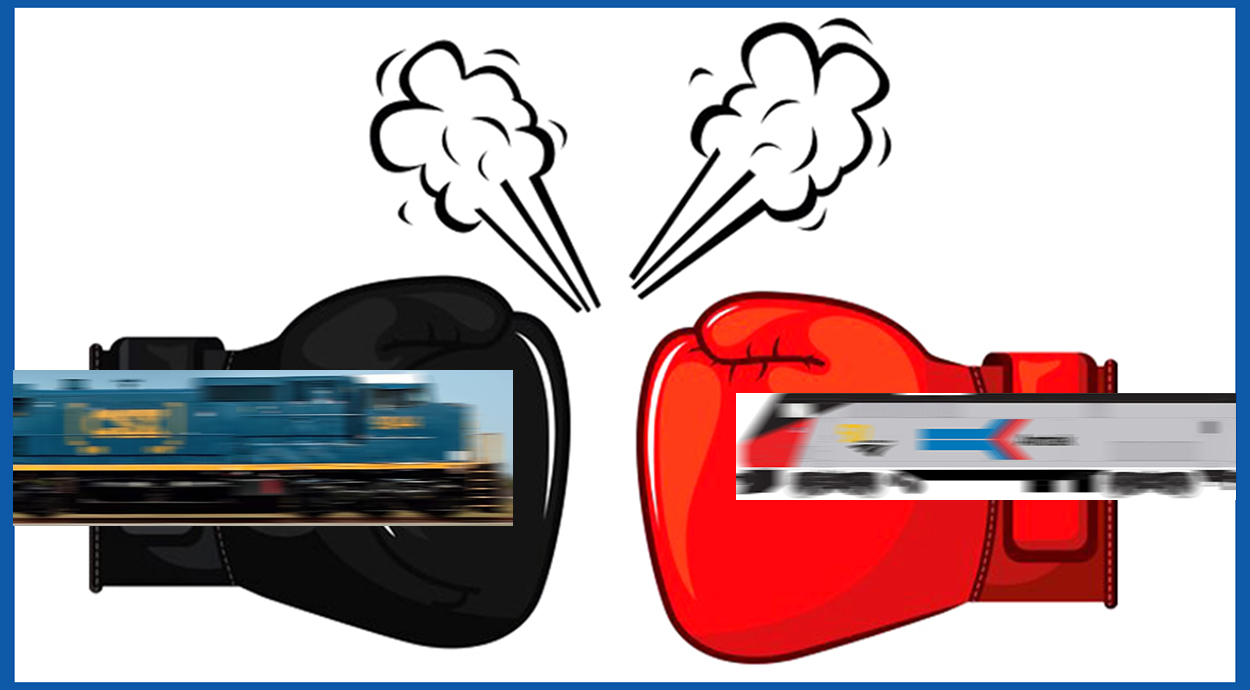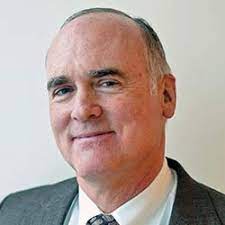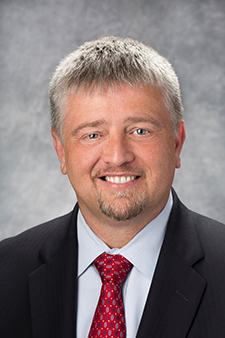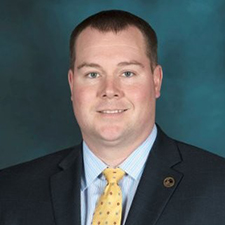
Round 4: A Battle Within a Battle
Written by David Peter Alan, Contributing Editor
The battle between Amtrak and potential host railroads CSX and NS, joined by the Port of Mobile, entered a new stage April 4, as the first witnesses began their appearances before the Surface Transportation Board (STB) in the first case that will decide how and on what conditions Amtrak will be allowed to initiate new passenger service. The entire afternoon and the start of proceedings on April 5 featured a single witness. There was only one more during that day’s 8½-hour session, and only one other on April 6. April 5’s morning’s events featured a skirmish within the principal battle: a mini-slug-out in which both sides can claim victory, but CSX may have been the bigger winner.
As we reported previously, this is a case of first impression. In effect, the matter is a trial before a specialized tribunal, rather than the standard trial of a civil case before a judge and a jury. Everyone concerned seems to be feeling their way through this hearing, in order to establish precedents for other cases under the new statutory jurisdiction that Congress has given to the STB in matters of this sort.

The first witness was consultant Charlie Banks, President of R.L. Banks and Associates, supporting CSX. His main topic of conversation was a traffic simulation that his firm conducted of the Gulf Coast line at issue. After describing his career and the firm, he described Rail Traffic Controller (RTC), the program that crunches the numbers for modeling studies of the sort conducted on the Gulf Coast line. Banks described how it works: It takes data on existing capacity constraints including infrastructure, and data on demand for that capacity, which would include weights, lengths and train schedules. If the simulated railroad can run, there is sufficient capacity. If not, it is necessary to build more infrastructure to increase capacity or reduce demand on existing capacity. The model can simulate operations under different scenarios and conditions.
Banks described an RTC study as the “gold standard” for modeling railroad operations, and said that his firm has done such studies for passenger railroads, freight railroads, shippers and suppliers; with each group supplying about one-quarter of their work in that field. He also attributed his firm’s success in large measure to integrity. Regarding the Gulf Coast line, Banks called it “challenging territory” in physical and operational terms, and described it, with its seven movable bridges between Mobile and New Orleans and with its comparatively few sidings. He offered the opinion that adding the two daily round trips that Amtrak wants to run without infrastructure upgrades would degrade the existing freight service, and said that it was “foolish not to take advantage of the RTC model.”
Amtrak attorney Kali Bracey then cross-examined Banks. She asked him for details of the RTC studies his firm had done for CSX, cost methodologies, assumptions about growth in freight business along the line, prior RTC studies, and parameters of the RTC study. She was not the only person who questioned Banks extensively. So did STB Chair Martin Oberman, and there were occasional questions from Board member Patrick Fuchs. Oberman acknowledged Banks as a “major expert” and asked about what knowledge he had of how costs were determined, evaluation of projected growth in freight business, and other topics related to CSX’s contentions. In response, Banks defended the study by saying: “You are conflating the model with the report.”
When Oberman asked Banks if he was making a record for requiring that new infrastructure projects be completed before the trains run, Banks said that, without it, freight service would fail and the host railroad would be blamed, so the 14 projects that CSX claims are needed should be built. He said that 11 of those projects were needed in advance of the Amtrak start, but there was no RTC simulation run with those 11 projects in place.
There was an incident on April 5 that clearly demonstrated the difficulties in establishing those precedents. It was first discussed in a private session, and then Oberman directed that it again be discussed in the “public session” on the record, including streaming on the Board’s You Tube channel.
Ray Atkins, the attorney for CSX, asked the Board members to limit their questions to those of “a clarifying nature.” His colleague, Dan Donahue, made the argument. Donahue analogized the Board’s function to that of a judge in a civil trial. He invoked Rule 43 of the Federal Rules of Civil Procedure and said that the Board can’t appear like an advocate or prosecutor. He cited case law and claimed that the Board was usurping the function of Amtrak’s counsel. He then argued that the Board’s questioning of witnesses constituted “potential reversible error.” By so doing, he threatened that CSX (and probably NS and the Port, too) would take an appeal if the Board does not find in their favor.
On the Board’s behalf, Oberman stood his ground. His response began: “I would not limit or cut off Board members from asking questions” and added that the Board is not “a passive arbiter.” He said that the Board has an obligation to protect both freight and passenger operations, as part of acting in the “broad public interest.” He also said: “I want facts on the record that will sustain any decision we reach.” He noted that the rule cited by CSX is designed for jury trials and distinguished the present case, where the Board needs detailed information to rule on technical issues. He concluded by saying: “You can do what you want to serve your client’s interest. We will serve the public interest.”
In response to Oberman’s stand on behalf of the Board, Atkins said that CSX would brief the issue, and began objecting to many of the questions that Oberman and other Board members asked witnesses. Oberman overruled those objections routinely.
To this writer, it appears that Oberman was correct in stating the purpose and parameters of the Board and distinguishing a case like the present one from a jury trial. It appears unlikely that the D.C. Circuit Court were to reverse the Board if CSX, NS, or the Port mount an appeal. Nevertheless, Amtrak’s adversaries won a victory of sorts merely by threatening an appeal. As we reported earlier, any delay serves their interests. Until this matter is resolved, Amtrak will not know for sure how many projects must be built to accommodate the new passenger trains, and how much the total cost will be. Until a precedent for such determinations is established under this case, other proposed projects in Amtrak’s 2035 plan cannot go forward, because they would face similar opposition from potential host railroads. As such, delay in reaching a final resolution to the present case also delays the entire Amtrak initiative.
After that issue was resolved, at least for now, the case continued with redirect examination of Charlie Banks. That occurs when the lawyers on the witness’ side of the case ask non-hostile questions to clarify issues raised by their opponents in cross-examination. That examination was relatively brief, and it was then time for the next witness.

He was Ricky Johnson, Senior Vice President of Mechanical and Engineering at CSX. He was “on the stand” for the rest of the day. He spent much of that time describing the Gulf Coast line in detail, from major yards east of where the proposed trains would stop in downtown Mobile, going railroad south to the junction with NS at Gentilly Yard in New Orleans; 138.5 miles of railroad. This is the New Orleans & Mobile (NO&M) Subdivision, which Johnson described as single-track for 80% of its length, with seven movable bridges between New Orleans and Mobile, and more east of there that affect freight operations on the NO&M. He said the line costs 460% more to maintain than average on CSX, but also said that it is a major gateway to New Orleans, with the second-largest volume of freight interchange on the CSX system.
Johnson said: “We welcome passenger trains, but it’s about doing it the right way.” He even said: “Bring ‘em on!” but continued by belittling those trains, claiming that the issue was balancing trains with an average of 26 riders against 56 freight customers and all the jobs that would be affected. He called for the new station to be located at Brookley Airport (which is about five miles from downtown Mobile), rather than at the former location downtown, which Amtrak claims is the best place for trains to stop. Johnson claimed that trains would dwell for 10 to 15 minutes at stations if new station tracks are not built, though Amtrak’s proposed schedule calls for a dwell time of two minutes at each intermediate stop. Johnson detailed the disruption to freight service that he expected to result from passenger trains. He showed drone footage of much of the line, especially in the Mobile area, where the yards are located east of the downtown location where Amtrak wants to establish a station. He also led a virtual “tour” of the seven bridges on the line to New Orleans.
On cross-examination, Amtrak attempted to show that CSX ran more trains in 1995-96, when Amtrak ran one train on the line, then the railroad runs today. Amtrak also challenged CSX’s growth forecast and noted how slowly CSX’s freight trains run, and asked about an “Amtrak track” in Chocktaw Yard that was used for layup in Mobile in 1996-97, among other operational and infrastructure topics.
Board members had questions, too. Oberman elicited that CSX now runs longer trains: “clearing trains” fewer than 8,500 feet long and “non-clearing” trains longer than 10,000 feet, which cannot fit onto sidings, in one direction. “Clearing trains” in the other direction take the siding. Robert Primus asked about the cost of maintaining the NO&M, which Johnson said was 460% of the average maintenance on CSX, and that Hurricane Katrina added to that cost. He added that he “did not want to build one more foot than we have to.” Patrick Fuchs asked if CSX compared costs of building new infrastructure or finding other ways to serve customers, and Johnson answered in the affirmative. Karen Hedlund suggested that there might be operational workarounds.

Randy Hunt, Senior Director of Interline Services at NS and an attorney working for the railroad in a non-legal position, was the witness on April 6. He had negotiated with Amtrak and supervised Amtrak crews operating on NS, and was examined by trial counsel Dan Donanue on direct. He mentioned the Piedmont Project in North Carolina, as well as projects in Virginia that allowed Amtrak to add service to Norfolk and Roanoke, Va. He also said that all three used RTC modeling, and that new infrastructure was built before the additional trains ran. Concerning the Crescent (Trains 19 and 20), which runs on NS between Alexandria and New Orleans, he said: “The Crescent has historically been performance-challenged” and noted that NS created a 45- to 60-minute window for it on the Back Belt, the stretch of track in New Orleans where the proposed Gulf Coast trains would also run. He said that window cuts capacity down to 22 hours a day and, without infrastructure improvements, adding similar windows for Gulf Coast trains would cut it down to 18 hours a day. He claimed that the Back Belt was not included in studies conducted by the Gulf Coast Working Group, even though it is the route for all New Orleans interchange. Hunt described the Back Belt in detail and showed drone footage depicting it. He said it is slightly more than three miles long from the Amtrak transfer point to East City Junction, and there are 15 to 22 freight movements on it daily. One of the projects NS mentioned as benefiting Amtrak would extend the Freight Lead from 3,500 to 12,000 feet along the Back Belt line and add crossovers.
To restate his main point, with the new trains and without the infrastructure he called for, Hunt said “We’re going to have to put the ‘closed’ sign up for four more hours.” He also expressed concern about precedent for the Amtrak Connects US map; that Amtrak will want to “arbitrarily insert” trains “without consideration of the infrastructure and without the infrastructure to mitigate those impacts.”
After lunch, Amtrak cross-examined Hunt. He said freight had to be stopped in advance, so Amtrak could have a clear route, even though Amtrak counsel Jessica Adamson said it takes eight minutes for the Crescent train to traverse the Back Belt. Hunt also mentioned reliability problems for the Amtrak train southbound, which is known to run on NS since Alexandria, Va.
Cross-examination ran for about 40 minutes, and then the session moved into a “breakout room” to discuss documents marked “confidential.” That session lasted for 2 hours and 52 minutes. When cross-examination resumed, Hunt acknowledged that he denied access to Amtrak’s crews as “premature and unreasonable.” He continued to assert that the infrastructure that CSX wanted would “preserve our ability to do business” rather than to improve the railroad’s operations. Looking at the RTC model, he was concerned about impairment in the 2039 operating scenario. Much of the subsequent discussion pertained to the model. After a few more minutes, the day was over. The railroads expressed their hope to present three witnesses on Friday, although one per day was all they could manage for the first three hearing days.
While its adversaries presented witnesses, Amtrak managed to tell its side of the story a different way. Amtrak and the Southern Rail Commission (SRC) had set up “watch parties” in Bay St. Louis on April 4 and 5, and in Pascagoula on April 6. Amtrak and SRC officials would be there, according to Amtrak press releases, which also said: “The U.S. Surface Transportation Board (STB) will hold an evidentiary hearing regarding CSX and Norfolk Southern railroads blocking Amtrak from operating passenger trains between Mobile and New Orleans. For more than seven years, this important service has been discussed and repeatedly studied, including by a working group led for 18 months by the U.S. Federal Railroad Administration.” Bay St. Louis and Pascagoula are the only two stations that would be served by the proposed Gulf Coast trains that have no intercity or local fixed-route buses.
Amtrak spokesperson Marc Magliari also posted a video on You Tube of time-lapse pictures of the railroad at Pascagoula as the trains went by. The opening message said: “How #NotSoBusy is the is the CSX railroad on the Gulf Coast? We captured a time-lapse to count the number of trains using the route form 6 A.M. to 11 P.M.—far beyond any times Amtrak would operate there. Pay attention to the Pascagoula Bridge, which goes down to let trains pass through.” Spoiler alert: They counted 7 trains. A release that Magliari issued on Wednesday bore the headline: CSX finally gives a train count to a reporter (not that others haven’t tried). The cited a Vice/Motherboard story from April 6 that bore the headline Amtrak Is Streaming an Empty Railroad on Twitch to Beef With Freight Rail Companies. In his story, Aaron Gordon reported Amtrak’s media campaign and quoted a CSX spokesperson as saying: “It takes a freight train about 8-10 hours to travel between New Orleans and Mobile” (the Amtrak trains would take slightly less than 3½). The final paragraph contained the breaking news: “CSX responded to Motherboard’s question about how many through trains it runs on this route per day: 8-10 through trains, 1-3 coal and grain trains, and ‘numerous local trains.”



